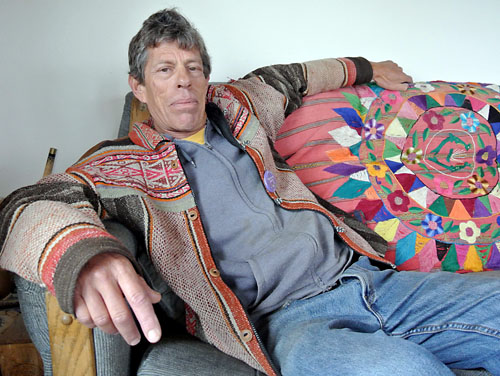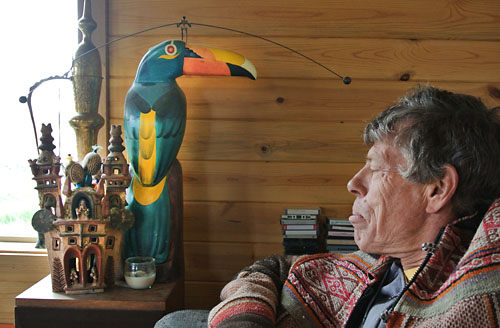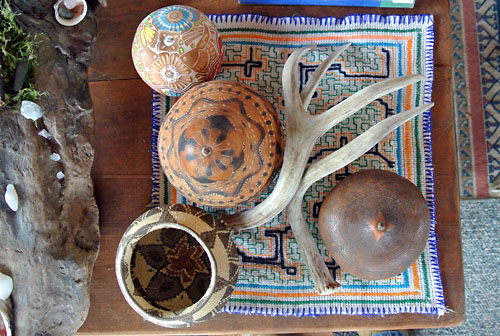|
Between Two Worlds
Randy Levine
story and photos by Virginia Rivero Descailleaux
It was a cold, rainy Saturday morning when Randy Levine received me at his home in the highlands of Twisp. As the door opened, a warm, cozy and very colorful living room full of souvenirs and beautiful handcrafted items from abroad brightened the day. “Would you like a cup of coca leaves tea? I brought it from Peru,” he said, in perfect Spanish. I was expecting to talk to him about the jewelry Randy brings from South America, which he sells every Saturday morning at his stand in the Methow Valley Farmers Market (a.k.a. Twisp Farmers Market). Instead, I found out Randy’s real story, a story of philanthropy that goes beyond his entrepreneurial spirit.
 Randy Levine at ease in his Methow Valley home. Levine moved to the Methow Valley when he was 20 years old. Originally from Atlantic City, New Jersey, Randy moved to the valley when he was 20 years old while traveling around the U.S. with a bunch of friends. One of them decided to buy 90 acres of land in this area to raise horses, but the lot had to be cleaned up and trees removed. Randy, along with eight friends, did the job. By the following spring, he fell in love with the Methow Valley and decided this would be his new home.
Randy began working in construction, building roads, carrying cement and other heavy loads. But his back couldn’t take the pressure and he was forced to stop that career. In 1986 he decided to roam around South America for the first time. Argentina, Paraguay, Bolivia, Ecuador, Brazil, Venezuela and Colombia were some of the countries he visited. But one country caught his full attention and ignited his cultural passions: Peru.
For people visiting Peru, the Inca ruins of Machu Picchu near Cuzco are a must-see. Nowadays considered one of the seven new wonders of the world, Randy was impressed with the view, the history and its cultural significance.
Back in Washington, Randy set up a stand at the Twisp Farmers Market to sell the peaches harvested from his 30-tree lot in Pateros. Things were going well for him, but his mind was set on the Peruvian culture and, most specifically, its art. One year passed by and Randy returned to Peru to explore a little bit more of its cultural legacy.
This time, the trip lasted three months, which allowed him to travel to many places within the country. He thought he would share his travel experience by bringing some jewelry made by locals and other handcrafted items back to Washington to sell at the market. The first time, he brought back a small backpack. Next trip, he brought back a bigger luggage full of merchandise. Randy made one more trip to Peru, and the business was official: He brought back 220 lbs. (100 kilos) of handcrafted Peruvian art by cargo.
For the past 25 years, Randy has been bringing merchandise to the Twisp Farmers Market straight from South America. Ceramic and wood carvings featuring indigenous details, tapestries and textiles for walls, furniture and floors, elaborate altarpieces, gold-coated candles, handbags, hats, sweaters and scarves, as well as original jewelry made by locals were some of his valuable imports.
 Randy Levine with some of the art he has brought to the Methow Valley from South America. He now imports only jewelry for his business. Throughout the years, Randy commercialized these items not only at various markets within Washington, but also by sending merchandise by mail to stores in California, Oregon and Idaho. Unfortunately, he realized U.S. buyers were not fully appreciating the cultural implications of the items. Moreover, due to tax issues and increasing complications with import forms and permits, he decided to continue his business bringing only Peruvian jewelry.
A SOCIOLOGICAL EXPERIMENT
As thrilled as he was to experience a new culture and everything it had to offer, he also realized the deep economic problems in which the southern country was immersed. Curiosity took him to areas never explored by other foreigners before, places unimaginably remote in the Andes where indigenous communities live, maintaining their traditions and customs, and even the local ancient dialect, Quechua.
Randy felt the need to help these communities. Every time he came back to the US, he would gather clothes, shoes and toys for the children living in the poor communities. Then, in Peru, he would travel miles by bus and foot to reach these isolated places.
“Indigenous people are defensive when I arrive because they think I’m a gringo who works for a mining company aiming to take away their land for resource exploitation or that I’m a missionary trying to change their religious views –until they see the donations I have brought for them,” Randy said.
In fact, Randy’s social work is not a safe one in these areas. There is a legend spread for centuries throughout Andean communities about Pishtaco, a mythological boogeyman figure believed to abuse and kill locals. To preserve their safety, sometimes Andean aboriginals take the law into their own hands and make intruders “disappear.”
But Randy’s positive aura backs up his cause—and his safety. Around 50 children would gather around the various donations laid on a large floor mat and pick one item using a ticket Randy provides. “It is interesting how the kids would go first for the shoes than for the toys, even the youngest ones,” Randy stated with a glum expression.
Cuzco and Ayacucho are two of the provinces he helps the most. Randy usually picks the most isolated towns where there’s no tourism at all. And even though tourist agencies and even local TV networks have asked him to take them to these remote areas to either exploit their tourist resources or to catch a good story, Randy has adamantly said no. To Randy, these communities should not be disturbed by the frenzy of the modern world.
 More of the hand-made South American art and objects that fill Levine's home. So far, he has helped around 15 to 20 communities in need. “People are always very grateful, but when they ask me when I will be coming back, I say ‘Never!,’ he smiles. “There are just many more other towns that need help, and I plan to visit as many as possible.”
SATISFACTION
Certainly, Randy’s social work goes beyond these visits. He also manages to keep his jewelry providers satisfied. Recently, he bought a special machine for a provider friend in Lima, who needed it to significantly improve his business of ring engraving. In exchange, Randy only expects a good friendship. “I have many friends in Peru, musicians, artists, politicians—and my providers are my friends too,” he affirms. “They have a nickname for me: the Mick Jagger of Peru.” Indeed, his resemblance to the British singer is undeniable.
Back in Washington, Randy keeps his customers happy as well. “I have plenty of clients that come to my stand every single year to get their jewelry collection.” When he used to import bigger items, he sold a tapestry originally made by local artisans from Ayacucho to Sun Mountain Lodge for $2,000.
Randy’s dream is to live four months in Washington, during summer, and the rest of the year in Peru. He just bought an apartment in downtown Lima, and plans to move there before the year ends. But as much as he feels a connection with the South American country, he cannot completely detach from the Methow Valley.
“We live in a very healthy valley, with lots of nature, outdoor activities and amazing things to offer to everyone who resides here,” Randy states. “While Peru provides me with great energy, cultural diversity, and a sense of self-consciousness that makes me feel connected to the universe in many levels, the valley offers me a sense of community hard to find anywhere else.”
As I left his beautiful, very country-like American cabin, Peruvian creole music sounded harmoniously in the background.
11/20/2013
see past stories in the archive >>
|
